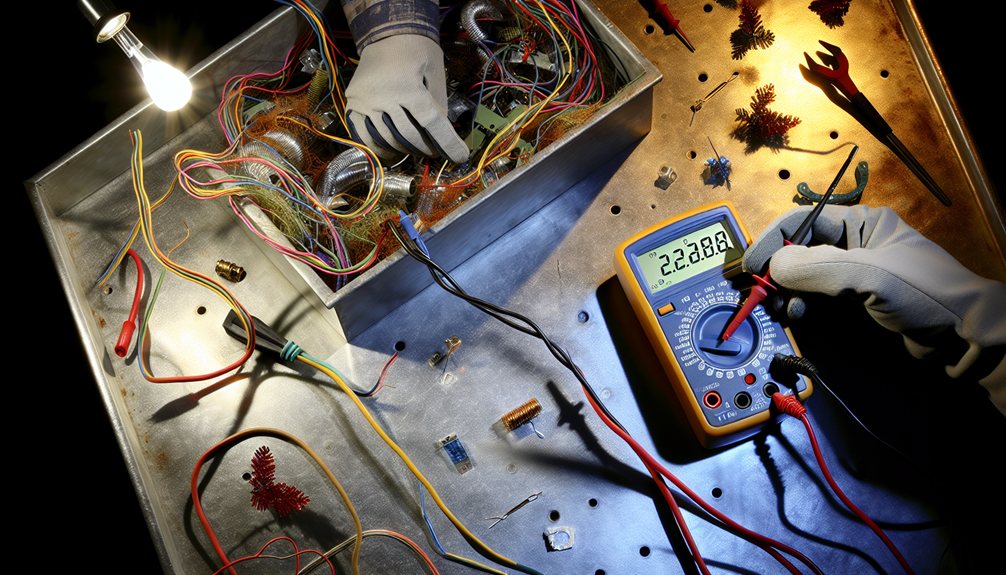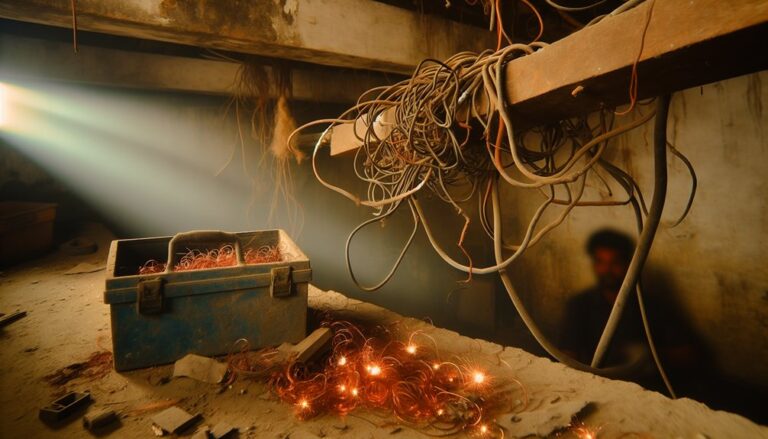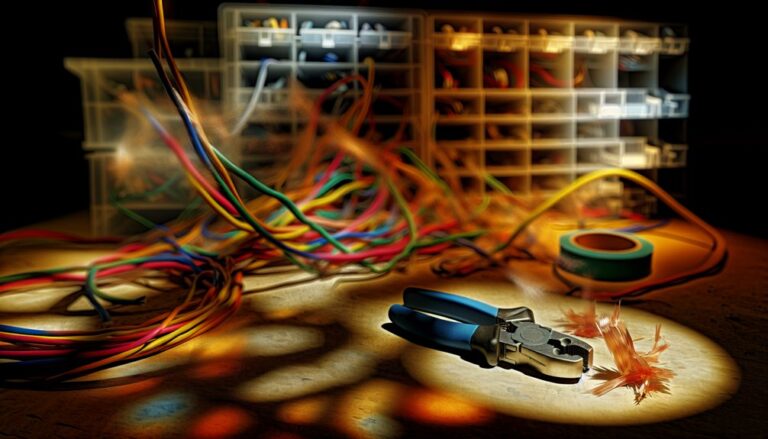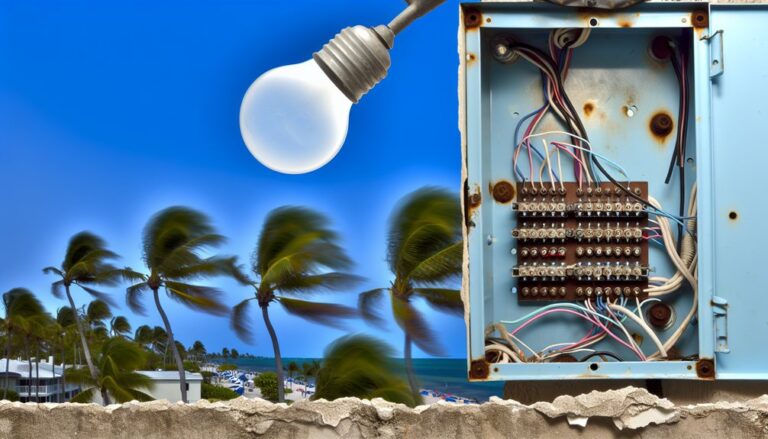Troubleshooting Wiring Errors
When troubleshooting wiring errors, start by closely inspecting your wiring for common mistakes like improper connections or undersized wires. Use a multimeter to measure voltage and continuity, helping you pinpoint issues such as shorts or overloaded circuits. Confirm all connections are secure and check for loose or damaged components. Don’t overlook safety—de-energize circuits before working on them. By following these steps, you’ll sharpen your skills and tackle wiring problems with confidence, revealing further key details along the way.
Key Takeaways
- Always refer to wiring diagrams to ensure accurate connections and prevent errors.
- Use a multimeter to check for voltage, current, and resistance issues in circuits.
- Inspect for loose terminals and damaged insulation to identify potential faults.
- Look for signs of overheating, such as warm outlets or tripped breakers, indicating overloads.
- Secure all connections properly to avoid intermittent faults and enhance system reliability.
Common Wiring Errors to Watch For
When troubleshooting wiring errors, it’s crucial to identify common mistakes that can lead to malfunctions or safety hazards. One frequent error is failing to follow wiring diagrams accurately, which can result in improper connections. This oversight often causes voltage drops, affecting the performance of electrical devices.
Another common mistake is using wires that are undersized for the load, leading to overheating and potential fire risks. Additionally, neglecting to secure connections properly can create intermittent faults, complicating diagnostics.
You’ll want to check for loose terminals and damaged insulation as well. By being aware of these errors, you can enhance your troubleshooting process and promote a safer, more reliable electrical system.
Essential Tools for Troubleshooting
Effective troubleshooting requires the right set of tools to diagnose and resolve wiring errors efficiently. A multimeter is crucial for measuring voltage, current, and resistance, allowing you to pinpoint issues accurately.
Familiarize yourself with multimeter usage, as it enables you to test circuits and identify faulty components. A circuit tester is another essential tool; it helps you quickly verify whether a circuit is live or if there’s a break in continuity.
Using these tools effectively can save time and enhance your problem-solving skills. Confirm you have both a reliable multimeter and circuit tester on hand, as they’ll provide the insights needed to tackle wiring errors and maintain a safe electrical system.
Identifying Electrical Shorts
How can you quickly identify electrical shorts in your wiring? Start by conducting a thorough visual inspection, looking for any signs of damage, burning, or exposed wires.
Next, use a multimeter for short circuit identification; set it to continuity mode and probe the circuit. If you hear a beep, you’ve found a short.
Additionally, disconnect power to the circuit and isolate sections to pinpoint the fault. By systematically testing each segment, you streamline your electrical fault diagnosis.
If you’ve narrowed it down to a specific device, inspect it closely for defects or improper connections.
Understanding Grounding Issues
Grounding issues can lead to significant safety hazards and equipment malfunctions, so it is crucial to understand their underlying causes. Proper grounding techniques are critical in ensuring electrical safety and system reliability. Familiarizing yourself with grounding symbols can help you identify and rectify grounding problems effectively.
| Grounding Technique | Purpose |
|---|---|
| Solid Grounding | Provides a low-resistance path to earth |
| Grounding Rods | Dissipate electrical surges |
| Ground Fault Circuit Interrupters (GFCI) | Protects against shock hazards |
| Bonding | Connects non-current-carrying metal parts |
| Isolated Grounding | Reduces noise in sensitive equipment |
Recognizing Overloaded Circuits
What signs indicate an overloaded circuit? First, you might notice circuit breakers tripping frequently, which is a clear indication that the current exceeds the safe limit.
Additionally, flickering or dimming lights when appliances are turned on often suggest overloaded circuits. You should also be wary of outlets or switches that feel warm or emit a burning smell, as this can indicate excessive heat from overloading.
If you notice any of these symptoms, it’s vital to assess your power distribution. Overloaded circuits can lead to serious hazards, including electrical fires.
To prevent this, consider redistributing your electrical loads across multiple circuits to balance the demand and guarantee safe operation.
Checking for Loose Connections
One common cause of electrical issues is loose connections within your wiring system. These loose wires can greatly impact connection stability, leading to erratic performance or complete failure.
Checking for these loose connections is vital to maintaining a safe and efficient electrical environment.
- Flickering lights
- Intermittent power supply
- Overheating outlets
- Unresponsive switches
- Circuit breaker trips
To identify loose connections, inspect wiring junctions, outlets, and switches. Gently wiggle the wires; any movement indicates a potential problem. Confirm terminals are securely tightened and free from corrosion.
Addressing loose connections promptly can prevent more severe electrical problems, improving overall system reliability and safety. Don’t overlook this essential step in troubleshooting wiring errors.
Testing and Replacing Faulty Components
After verifying that loose connections are addressed, the next step involves testing and replacing any faulty components in your electrical system.
Begin with component testing using a multimeter to check for continuity and proper voltage levels. Identify components that show abnormal readings, such as resistors, capacitors, and circuit breakers.
Once you’ve pinpointed the faulty parts, employ effective replacement strategies. For example, when replacing a capacitor, verify the new component matches the voltage and capacitance ratings required by the circuit. If a circuit breaker trips frequently, consider upgrading to a higher-rated breaker if applicable.
Document each step to track repairs and maintain system integrity. This methodical approach will enhance your electrical system’s reliability and performance.
Safety Precautions During Troubleshooting
While troubleshooting wiring errors, it’s crucial to prioritize safety to prevent accidents and injuries. Implementing proper safety measures not only protects you but also guarantees the integrity of the electrical system.
- Always wear personal protective equipment (PPE), including gloves and goggles.
- De-energize circuits before working on them to avoid electric shock.
- Keep tools insulated and in good condition to minimize risk.
- Familiarize yourself with emergency procedures in case of accidents.
- Maintain a clutter-free workspace to avoid tripping hazards.
About Us
We understand that electrical issues can be stressful and overwhelming. That’s why we are here to lend a helping hand and provide you with the best electrical services in town. As a team of experienced electricians, we take pride in our ability to solve any electrical problem with precision and care.
Pages
Follow us
Electrician Fort Lauderdale Today
Fort Lauderdale, FL 33301
© 2025 By Electrician Fort Lauderdale Today







